- Top
- About Fugu / Blowfish
About fugu (blowfish)
Appreciate a broad variety of dainty fugu (blowfish) dishes
– Origin of fugu cuisine and various fugu dishes
Fugu (blowfish) dishes have been loved since ancient times in different countries

In Shan Hai Jing, a book of geography written in China 2300 years ago, there is a statement "fugu kills people who eat it." In Japan, teeth of fugu were unearthed from a shell mound in the Jomon Period, indicating that fugu was already caught in that period. fugu is also mentioned in Honzo Wamyo, a herb book written in the Heian period.
Japanese food culture and fugu (blowfish)
A series of fugu poisoning resulted in the prohibition of eating fugu
Among samurai who gathered in Kyushu for the battles of Bunroku and Keicho, many died from fugu poisoning. This resulted in the publication of prohibition on eating fugu by Toyotomi Hideyoshi. Subsequently in the Edo period, many clans prohibited its samurai to eat fugu (the prohibition was particularly stringent in the Choshu clan). When eating fugu is uncovered, the family was confiscated of its hereditary stipend or underwent other harsh punishments.
From the prohibition of eating fugu to the lifting of prohibition
On the other hand, fish eating culture was highly developed in the Edo Period. In a cooking story written in 1643 in the Edo Period, a fugu soup was mentioned as a way to cook fugu.
"To make a fugu soup, skin the fugu, dispose of the organs, and carefully remove the hidden liver from its belly. Wash it well until no blood remains, and immerse it first in unrefined sake, and then add refined sake. Slightly dilute nakamiso and boil the soup, and add the fish. Once a bubble appears, pour a little unrefined sake, and adjust the salt seasoning. Use garlic, eggplant as a fragrant garnish" and so on.
Matsuo Basho and Kobayashi Issa, the famous haiku poets, made haiku using fugu dishes as season words (see the right).
Because fugu eating was strictly regulated, fugu dishes were not commonly eaten until the prohibition was lifted in the Meiji era, after Ito Hirobumi ate fugu at Shunpanro.
- *Because fugu was less smelly than other fish, fugu oil was used for lampstands in the Imperial Court, Shogunate, and upper class.
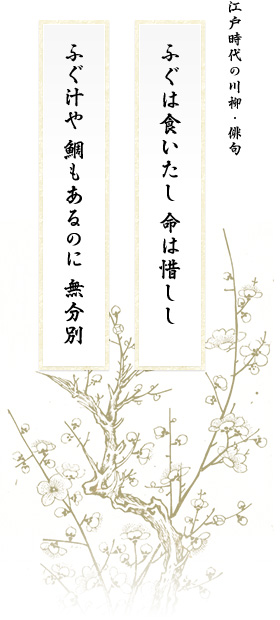
Fugu (blowfish) cook and license
Fugu cook
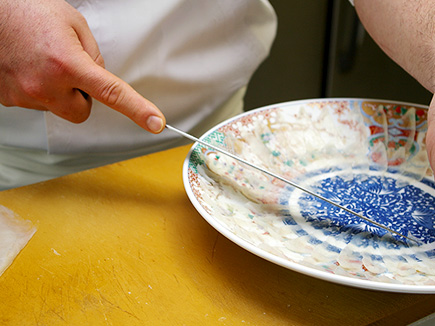
Fugu cooks are those who have passed the fugu cook examination and have been licensed by the governors of prefectures based on the fugu Ordinance. This is an occupational licensing, because only licensed cooks may cook fugu. The name of the qualification may vary by prefecture, such as fugu handlers, fugu processers, fugu cooks, registered fugu handlers, and fugu preparers. The license/qualification for fugu cooks is specified by each prefecture, and therefore is only valid within the relevant prefecture, unless otherwise specified. The eligibility for, and the difficulty of, licensing/qualification seminars vary by prefecture. fugu cooks are required to prepare fugu with correct knowledge and adequate processing skills. Cooks who have passed the fugu cook examination and who have been licensed by the governors of prefectures work at each restaurant of Shunpanro.
Types of fugu (blowfish) dishes
Course dishes

Fugu course
The essence of fugu dishes at Shunpanro exists in usuzukuri (thin slices). Cooks carefully examine each fish, and lays it until the moment when its flavor and texture reach the best. Then the fish is sliced so thinly that patterns on the Arita ware plate can be seen through it. The thin slices are put on the pate with their edges standing, in a motif of chrysanthemum flower.
Guests can appreciate the taste of fugu to the full in the tiger puffer course, the standard cuisine at Shunpanro, Shunpanro’s traditional; Usuzukuri; Chirinabe, a pot dish to enjoy hot fugu together with vegetables in kelp soup; Deep-fried fugu that encloses the flavor of fugu inside the crispy breading; and Zosui cooked with fugu soup.
Sliced fugu

Fugu sashi
"Fugusashi" refers to sliced fugu. This is also called "Tessa", short for "Tepposashi," because Kansai people call fugu "Teppo." Fugu meat is fibrous and elastic and is difficult to bite off. Therefore, it is typically sliced with a knife so thinly that you can see through the slices. Fugu meat to be used for fugusashi is laid for one or two whole days covered with a cloth after killing the fish.
The meat is thus matured. fugusashi is put on a large round plate in a decorative pattern, in the motif of a crane, chrysanthemum flower, peacock, peony flower, etc., in order to please the guests’ eyes. Sliced fugu is usually eaten with chopsticks, after dipping in Ponzu sauce. Guests can add momijioroshi (grated daikon with chile), negi (green spring onion), and other condiments that they like. Sometimes fugu skin that has been slightly boiled, cooled with iced water, and then sliced, is added to fugusashi.
Pot dish

Fugu chirinabe
This is a pot dish to enjoy cut fugu (blowfish) meat and fugu bone together with vegetables, boiled in kelp soup in an earthenware pot. Taste the pot together with recommended Ponzu sauce, Yasuokanegi(green onion), and other condiments.
Other dishes

Fugu hire sake (Sake with flowfish fin)
Skilled fugu (blowfish) cooks at Shunpanro carefully process and clean each fin of fugu, dry them in the sun, and grill them to a beautiful brown for putting them into sake. In order to keep the taste and flavor of these fugu fins, a brand of sake that has a good balance between sourness and sweetness is chosen to avoid excessive conspicuity.
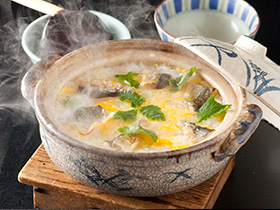
Fugu (blowfish) zosui
Fugu cooks take a good soup from fugu meat and bony parts, add fugu skin and meat into the soup, boil it lightly, and then add cooked rice after rinsing it to remove sliminess. Guests can add Ponzu sauce or daikon with chile as they like. This mildly finished dish is indispensable for closing the course.
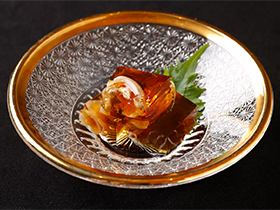
Fugu (blowfish) nikogori
Fugu skin is gelatinous, and is dissolved in water when simmered. Cooks mildly season it and cool it to gelatinize the collagen. Appreciate the wonderful taste that expands in the mouth on the moment you put the gelatin on your tongue.

Fugu (blowfish) sushi
Fugu sushi is great to enjoy tiger puffer, the main player at Shunpanro, together with Yasuoka negi, Ponzu sauce made from bitter orange, etc., in one fascinating bite. Different types of fugu sushi, such as nigiri sushi, temari sushi, maki sushi, and gunkan maki, can be prepared.

Charcoal-grilled fugu (blowfish)
Far infrared rays of charcoal fire grill the surface of fugu uniformly and quickly, while concentrating and enclosing its flavor inside. The delicate and profound taste of fugu, combined with the fragrance of charcoal fire, stimulates the appetite in summer.

Deep-fried fugu (blowfish)
Fugu meat is thinly seasoned to keep its flavor, and then deep-fried with a crispy surface. Hold the fry with your hands and bite it. The gelatin and bony part around the mouth is particularly tasty.

Fugu (blowfish) shirako sake
Shirako (testes) of fugu is the most delicious around January to March, when fugu lay their roes. Fugu shirako sake is made by adding Japanese sake to fugu shirako that has been carefully strained, and offers a very rich taste.

Grilled fugu (blowfish) shirako
Shirako (testes) of fugu is salted on the surface, and grilled slowly with some distance above fire. The surface becomes fragrant in a beautiful brown, and inside it feels like rich milk.
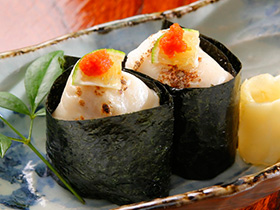
Grilled fugu (blowfish) shirako sushi
Shirako of fugu is salted on the surface, and grilled with some distance above fire. The shirako enclosing its flavor inside is made into gunkan maki. This sushi also pleases the eyes with a thinly sliced Sudachi citrus, accentuated with grated daikon with chile, put on it.
Shunpanro across JapanFugu (blowfish) and seasonal dishes
Shunpanro across Japan




